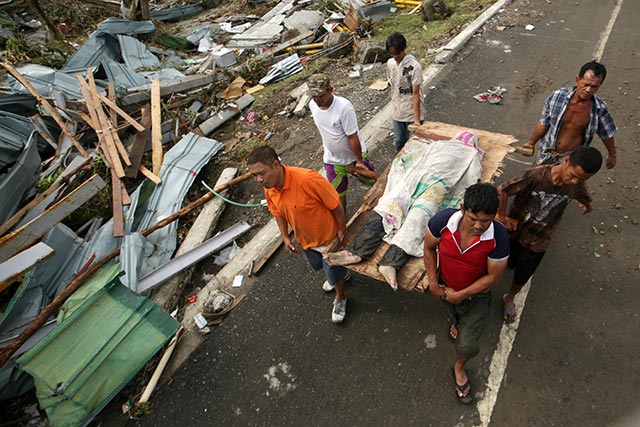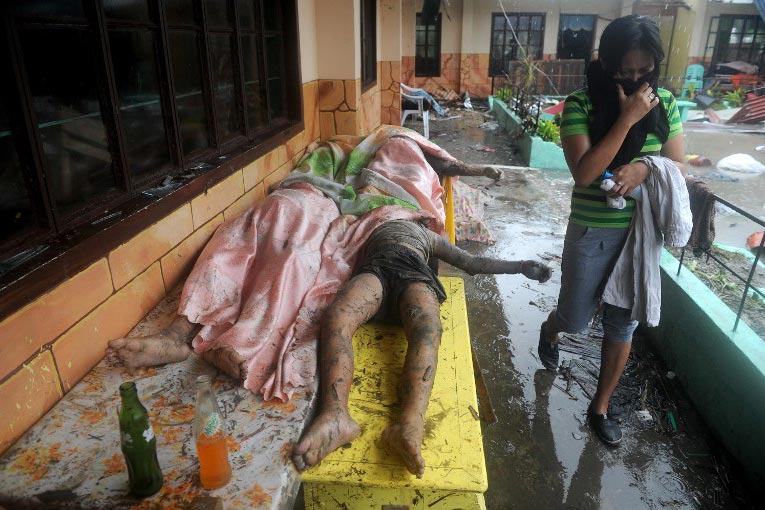One of the typhoon survivors Jaime Constantino,22, an Ateneo honors graduate and recently employed by the Procter and Gamble assigned to Tacloban, witnessed the deaths and devastation that ravaged the city that fateful Friday. Describing the area near the Oriental Hotel that was near the compound they were residing in, he wrote: “The path was littered with rubble, wood, fallen trees, and sharp rusted nails. Then I saw it. A body was unceremoniously wrapped in a banig (mat), and placed on the side of the road. Nobody was minding it. I’d seen dead bodies before, but never casually discarded. But we were helpless. Everywhere we looked, people were wandering. Maybe they were searching for food or shelter. Maybe they were looking for their loved ones. I saw an old couple sift through the debris perhaps in search for their belongings. I saw a teenage boy crying and shaking as he walked alone, looking for his family. I saw parents grasping hands of their children as they stood under what used to be a waiting shed. Everywhere we went, we asked for information. We walked for hours. We were told about the current state of downtown Tacloban. People were getting more and more desperate. Innumerable dead bodies were on the streets, unclaimed. The smell was terrible.”[i]
The Canadian Doug Nienhuis wrote in his journal his observations and impressions on the night after the storm: “Many of the bodies struck me as being in odd positions and laid out in unusual ways. Then I discovered that people had pulled them out of the water and laid them on the shore to be found and collected later. These people were busy collecting things from the shore – items that they could sell or use to rebuild their homes. The typhoon was barely over. The winds still raged and howled so loudly that night that people couldn’t sleep. Yet, there was no time for mourning or for shock. People instantly set about scavenging – pulling together piles of good timber that they could use to build a new home. There was no time to waste. If they waited, other people would grab the best material and they would be left with nothing. As they worked, they came across the bodies and took the time to pull them up onto the cement piers and the cement walls along the shore. The bodies lay there, exposed and vulnerable and sad. The water had stripped away most of their clothing, leaving, in most cases, just underwear. Some of them were still in the water, piled up on the rocks, the waves washing over them and moving their limbs and their hair. Skin and flesh had been scraped away by the rocks and wood leaving large patches of white bone. The elements did not waste any time in reclaiming these bodies. It was hard to believe that just hours earlier, they had all been living and vibrant humans, just like those climbing over the debris and scavenging around them. Now they were just flesh and already coming apart in the water. One man surprised me by being fully clothed. I wondered about his story. He was clearly a farmer, and he still had his machete in its wooden sheath wrapped around his body. A short distance further along the shore, I was surprised to see the tiny body of a baby boy laid out on the cement – almost as if he were sleeping. I hadn’t seen this boy until I was right beside him. I just happened to look down and was startled to see him at my feet. I half expected his eyes to open, and it was exceedingly strange to realize that they never would open again.”[ii]
Davao City Mayor Ronald Duterte, who visited Tacloban on Tuesday after the storm, appeared shaken by the sight of survivors alongside the dead. He said: “Death on the roads, no electricity, no food and water, and people walking on the streets like zombies, looking for food…I think God was somewhere else when the typhoon hit.” [iii]
(Continue here)
[i] Constantino, Jaime, “My survival story,” Nov. 17, 2013, Manila Standard Today. Jaime Constantino, 22, is an Economics-Honors graduate of Ateneo de Manila University
[iii] Lacorte, Germelina,“God was away when ‘Yolanda’ flattened Tacloban—Duterte,” Inquirer Mindanao, November 12th, 2013


No comments:
Post a Comment